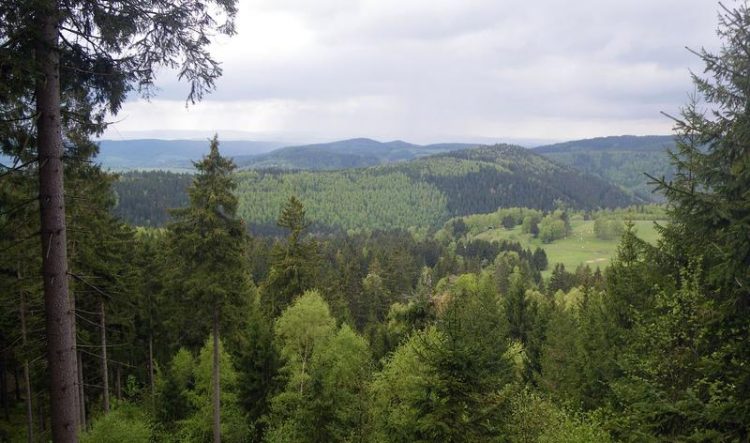Sustainable forest management contributes more to climate protection than forest wilderness

View of the southern slope of the Thuringian Forest. The mosaic of small-scale cultivation is clearly visible. Foto: Ernst-Detlef Schulze
Through photosynthesis, forests remove the greenhouse gas carbon dioxide (CO₂) from the atmosphere to build up biomass, but they also release CO₂ again through respiration and during biomass decomposition.
In the uncultivated forests of our temperate climate zones, these two processes are roughly in balance. The amount of CO₂ released by respiration and decomposition is approximately equal to the amount of CO₂ that is bound by photosynthesis to build up biomass.
In contrast, more CO₂ is bound in sustainably managed forests. Here, the wood growth is stronger than in non-cultivated forests because the stand density is controlled. In the forest, the wood supply remains constant, but the biomass gain is taken for harvesting.
It is used to provide firewood as well as short-lived and durable products, from toilet paper to construction timber. Durable wood products have a CO₂-saving effect at least during their lifetime, but they too have a limited life span.
The permanent climate effect develops only when wood is used to generate energy directly or after its use. Only then fossil fuels are replaced.
The climate balance of managed forests has so far been fragmentary, as previous national timber balances underestimate how much wood is consumed as an energy source.
In particular, the use of firewood in rural areas and for small privately owned forests has been insufficiently recorded. Sustainable timber harvesting in a commercial forest replaces about 900 litres of fuel oil per hectare and year or generates 7.4 megawatt hours of electricity and heat.
This corresponds to about 3.5 tons of CO₂, which are saved as emissions of fossil origin. The CO₂ emissions saved are even ten times higher than what is bound up in wood reserves in the nature conservation forest.
“The complete removal of forests from management therefore significantly reduces their contribution to climate protection,” concludes Professor Schulze from the Max Planck Institute for Biogeochemistry in Jena.
Currently, forest owners do not receive any recognition for the climate contribution of their commercial forests. On the contrary, logging is counted as an emission, although solid wood delivered to households or industry only releases its CO₂ during subsequent decomposition or combustion.
“We propose that the planned CO₂ tax on the burning of fossil fuels should be used to support the sustainable production of wood, in order to achieve the greatest possible contribution to climate protection,” concludes Prof. Schulze.
Prof. Dr. Ernst-Detlef Schulze
Max-Planck-Institut für Biogeochemie
Hans-Knöll-Str. 10, 07745 Jena
Tel: 03641 576100
Email: dschulze@bgc-jena.mpg.de
Web: https://www.bgc-jena.mpg.de/bgp/index.php/EmeritusEDS/EmeritusEDS
The climate change mitigation effect of bioenergy from sustainably managed forests in Central Europe
Schulze, E.-D., Sierra, C., Egenolf, V., Woerdehoff, R., Irslinger, R., Baldamus, C., Stupak, I., Spellmann, H. (2020)
Global Change Biology-Bioenergy, DOI: 10.1111/gcbb.12672
https://www.bgc-jena.mpg.de/bgp/index.php/EmeritusEDS/EmeritusEDS Webpage Prof. Schulze
Media Contact
All latest news from the category: Agricultural and Forestry Science
Newest articles

Red light therapy for repairing spinal cord injury passes milestone
Patients with spinal cord injury (SCI) could benefit from a future treatment to repair nerve connections using red and near-infrared light. The method, invented by scientists at the University of…

Insect research is revolutionized by technology
New technologies can revolutionise insect research and environmental monitoring. By using DNA, images, sounds and flight patterns analysed by AI, it’s possible to gain new insights into the world of…

X-ray satellite XMM-newton sees ‘space clover’ in a new light
Astronomers have discovered enormous circular radio features of unknown origin around some galaxies. Now, new observations of one dubbed the Cloverleaf suggest it was created by clashing groups of galaxies….





















